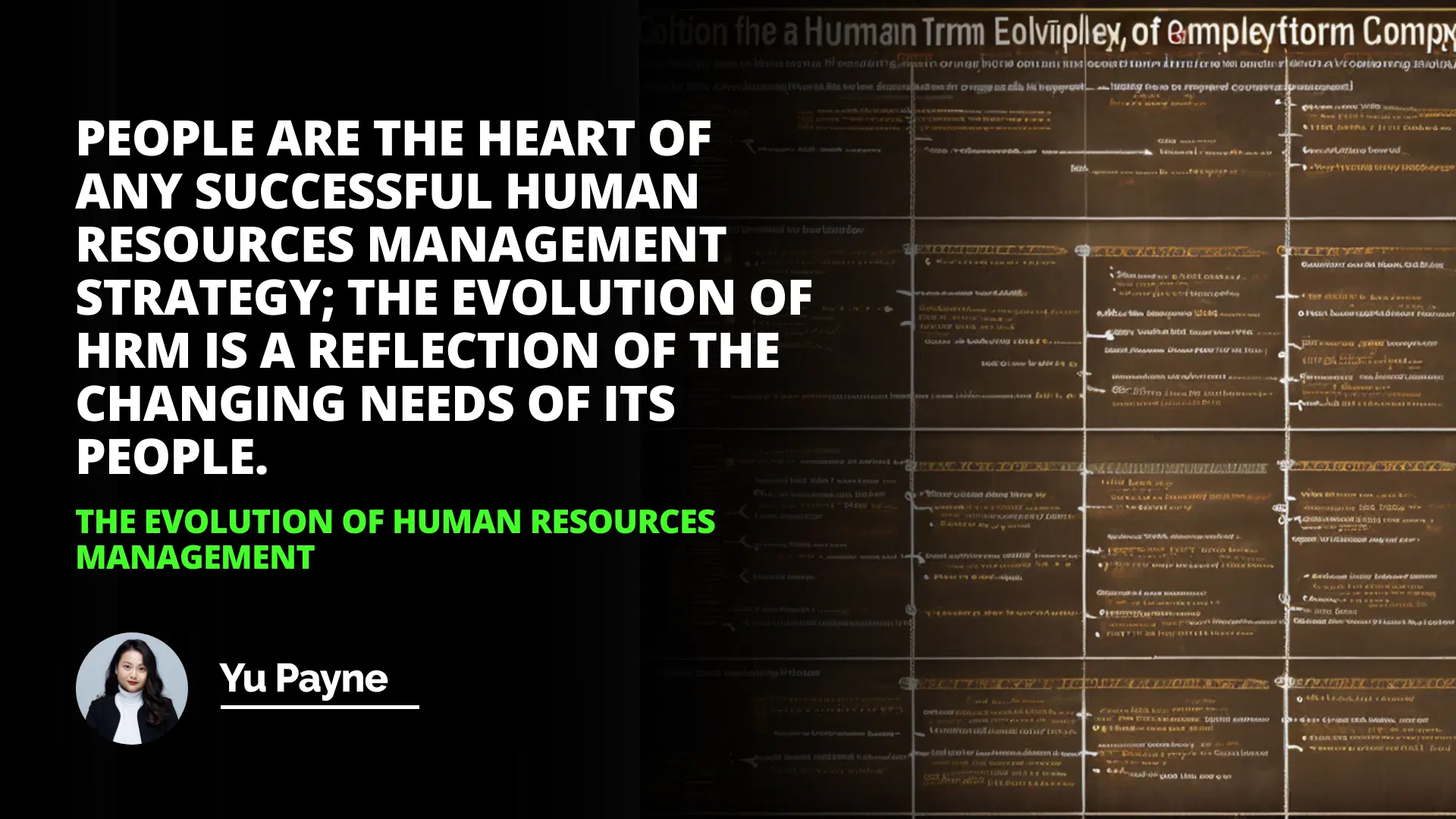
This article provides an overview of personnel/human resources history, beginning in the mid-1920s when managers handled their hiring and firing. As responsibilities for managers increased, a new department, referred to as the central office, was created to handle personnel duties. Then, with the rise of big unions in the 1930s, labor laws were made, and the role of Personnel was elevated.
During World War II, the personnel manager was established to recruit and retain employees. The emergence of the Personnel Management Association (PMA) in 1947 increased the visibility of Personnel. In the late 1950s, the PMA changed its name to the Society for Human Resource Management (SHRM). Today, human resources is an integral part of any organization, providing a wide range of services to ensure the business's success.
Related Course: Hr Certificate Programs
Introduction
The Early Years of Human Resources
The Rise of Big Unions in the 1930s
The Turning Point of World War II
The Growing Credibility of Human Resources
The History of Personnel/Human Resources
Personnel/human resources have a long and storied history, dating back to the mid-1920s. During this time, managers handled hiring and firing while office employees took care of other employee-related tasks. However, as managers' responsibilities began to expand, they had less and less time to focus on the employment process. This led to the emergence of a new department, unofficially referred to as the central office, which was tasked with recruiting, screening, and referring applicants for hire.
The scope of responsibility for this department, now called Personnel, gradually expanded to include directing recreational and social programs, organizing athletic teams, and arranging company picnics and dinners. Unfortunately, PersonnelPersonnel lacked administrative authority, which the rest of the organization did not take seriously.
The turning point for Personnel came in the 1930s with the rise of big unions. The unions provided a unified voice to represent the interests of employees and pushed for better working conditions and higher wages. This led to the emergence of labor laws, such as the Fair Labor Standards Act of 1938, which provided protections for workers and gave Personnel a more significant role in the organization.
The following central turning point for Personnel was World War II. With millions of men and women entering the military, companies had to find new ways to recruit and retain employees. This led to the emergence of the personnel manager, who was tasked with finding and keeping qualified employees. This role also included ensuring compliance with labor laws and regulations and developing and implementing employee policies and procedures.
The credibility of Personnel grew as the twentieth century progressed. The emergence of the Personnel Management Association (PMA) in 1947 provided a platform to share best practices and foster collaboration between personnel managers. This increased the visibility of Personnel and helped to legitimize the role within the organization. In the late 1950s, the PMA changed its name to the Society for Human Resource Management (SHRM), further cementing the importance of the human resources function.
Today, human resources is an integral part of any organization, providing a wide range of services to ensure the business's success. From recruiting and training to employee relations and compliance, human resources play a vital role in the success of any organization. As the part of human resources continues to evolve and expand, the importance of this function will only continue to grow.
People are the heart of any successful Human Resources Management strategy; the evolution of HRM is a reflection of the changing needs of its people.
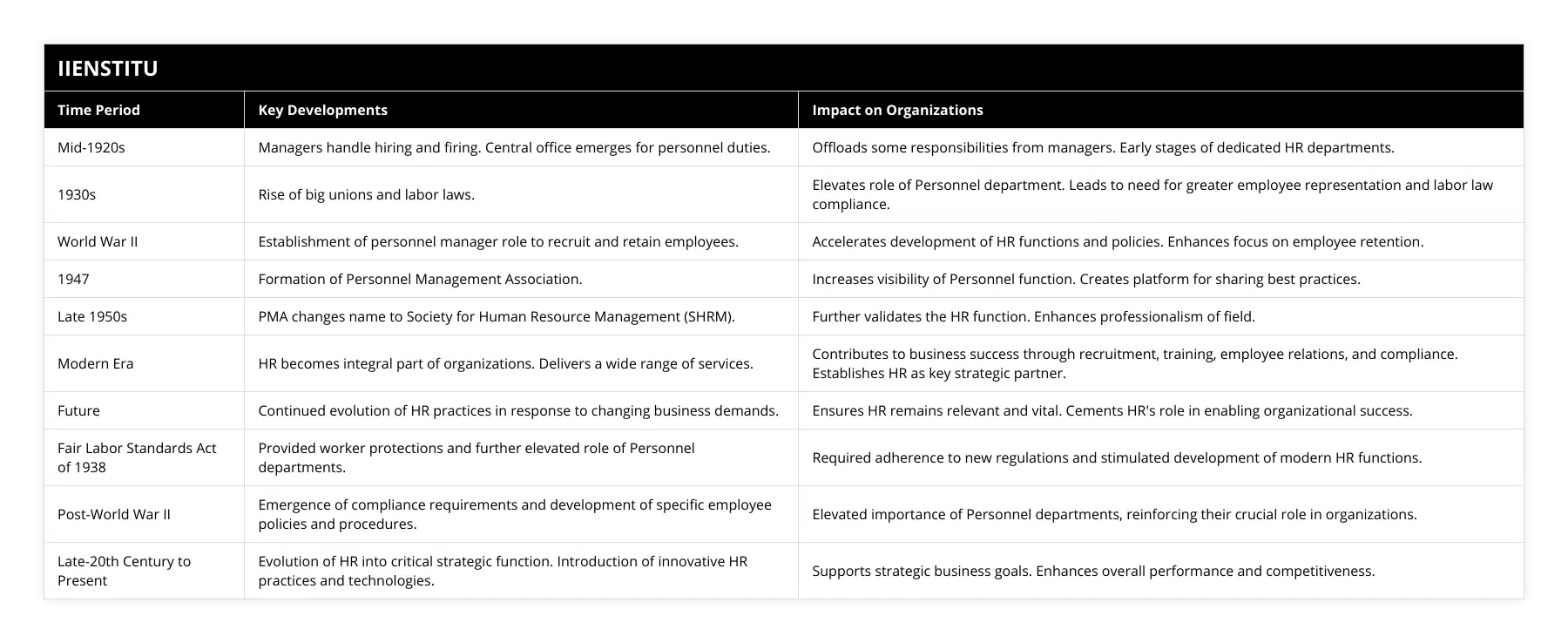
Frequently Asked Questions
The Modern Era of Human Resources
The modern era of Human Resources has brought a new level of efficiency, flexibility, and collaboration to the workplace. From streamlining the recruitment and onboarding process to leveraging data-driven analytics to inform strategic decisions, the Human Resources field has seen a tremendous transformation in recent years.
It is now possible for Human Resources teams to manage their entire workforce with a single system, enabling them to quickly and efficiently monitor employee performance, manage payroll, and track employee benefits. This level of integration has led to improved organizational efficiency and cost savings. Additionally, Human Resources can now access a wide range of data-driven insights to inform their decisions, allowing them to make informed decisions about their workforce and create tailored strategies to meet their objectives.
The use of technology has also enabled Human Resources teams to engage better with their employees. From employee engagement platforms to digital onboarding tools, Human Resources teams can now connect with their employees more meaningfully. This has improved employee retention, fostered a culture of collaboration, and allowed Human Resources teams to build more effective teams.
The modern era of Human Resources has also made it easier for organizations to attract and retain top talent. With the ability to access and analyze labor market data quickly, Human Resources teams can more easily identify the right talent for their company and develop targeted recruitment strategies. This has led to improved hiring processes and the ability to find the right people for the right job.
The modern era of Human Resources has enabled organizations to become more efficient and competitive in the workplace. With the ability to access relevant data, leverage technology, and engage with employees on a deeper level, Human Resources teams have created a more productive and successful work environment.

What changes in the field of Human Resources Management have occurred since the early years?
Over the years, Human Resources Management (HRM) has undergone several significant changes. As a result, theay's HRM is far more complex than it was in its early years. This article will explore the changes that have taken place in the field of HRM since its inception.
One significant change in HRM is the increased focus on employee engagement. This shift has been driven by the recognition that employees are the greatest asset of any organization and must be managed and engaged to ensure organizational success. As a result, HRM has become more focused on creating a culture of engagement, where employees are encouraged to be involved in the organization’s decisions and processes. Furthermore, HRM has also placed a greater emphasis on developing an effective performance management system that can be used to assess and reward employee performance.
Another significant change in HRM is the increased use of technology. Technology has enabled HRM to be more efficient and effective in its tasks. For example, HRM can now use automated systems to manage and track employee data and automate vital administrative processes such as payroll and benefits administration. In addition, technology has enabled HRM to access better and analyze employee data, allowing them to make informed decisions about employee training and development.
Finally, HRM has also seen a shift towards a more holistic approach to employee management. This has involved focusing on the overall well-being of employees rather than just their productivity. This has been driven by the recognition that employees need to be supported and nurtured to be productive. As a result, HRM has become more focused on creating a supportive work environment where employees are given opportunities for career development, recognition, and reward.
In conclusion, HRM has undergone several significant changes since its early years. These changes have been driven by an increased focus on employee engagement, the use of technology, and a shift towards a more holistic approach to employee management.
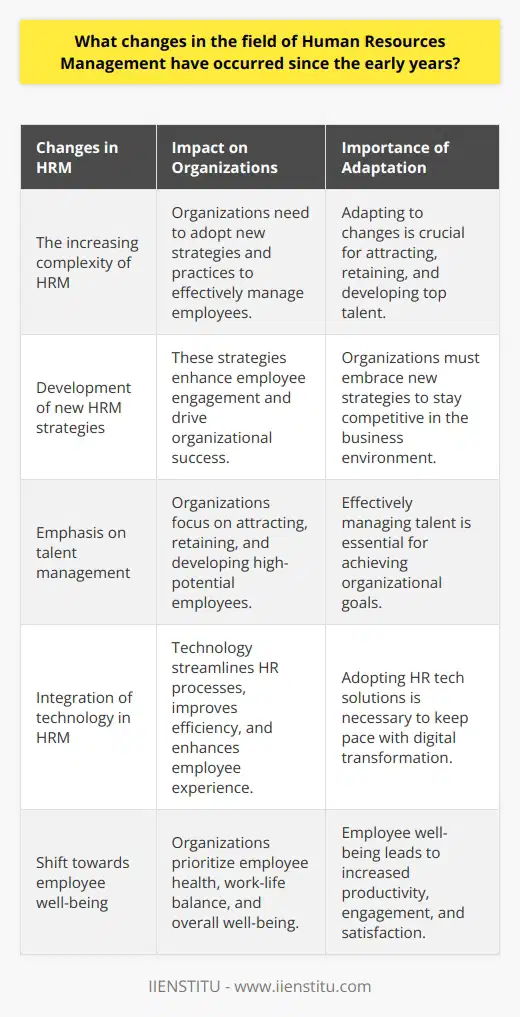
How did World War II influence the development of Human Resources Management?
Since World War II's end, human resources management (HRM) has experienced tremendous growth and evolution. Although the practice of HRM dates back to the early days of industrialization, the conflict of World War II was a significant catalyst for the development of HRM. The war created an unprecedented demand for workers and led to the need for large-scale recruitment and training and new organizational structures and management approaches.
At the start of the war, the military faced an acute personnel shortage, which necessitated the development of new recruitment and training methods. In response to this need, the U.S. government developed a standardized job classification and evaluation system, which private employers later adopted. This system provided a framework for employers to identify the necessary qualifications for a particular job and to determine the appropriate level of wages and benefits.
The war also had a significant impact on the way organizations were managed. As the demand for labor increased, employers had to create new organizational structures to accommodate the influx of personnel. This led to the development of the line and staff approach to management, in which specific personnel were assigned to specialized duties and were responsible for making decisions in their areas of expertise. This system allowed for more efficient decision-making, as well as for greater specialization of labor.
In addition, the war drove the development of new training and development programs. These programs sought to ensure that personnel was adequately prepared for their duties and provide them with the necessary skills to perform their jobs effectively. This was particularly important given the rapid technological advancements of the war years, which required workers to adapt to changing conditions quickly.
Finally, the war also catalyzed the development of employee motivation and engagement programs. Employers recognized that they needed to create an environment where employees felt valued and appreciated to maximize their productivity and commitment to the organization. This led to the emergence of innovative programs such as performance appraisal systems and employee recognition programs.
In conclusion, the conflict of World War II was an essential catalyst for the development of HRM. It created a need for new recruitment and training methods and improved organizational structures and management approaches. It also drove the development of further training and development programs and employee motivation and engagement initiatives. All of these advances helped shape the HRM field as we know it today.
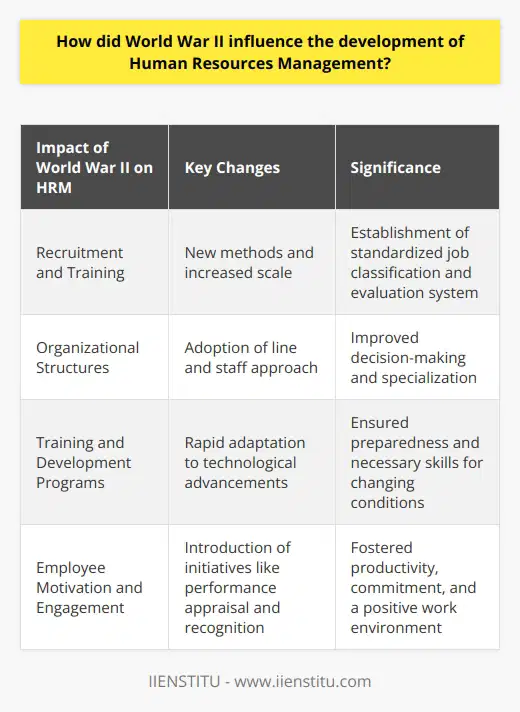
What are the primary factors that contributed to the early development and evolution of human resource management?
Historical Origins of HRM
The early development and evolution of human resource management (HRM) can be attributed to several primary factors: the industrial revolution, labor unions, and government regulations.
Industrial Revolution's Impact
The industrial revolution in the late 18th and early 19th centuries marked a significant turning point in the way organizations managed their workforce. As factories and mass production became the norm, businesses realized the importance of systematically recruiting, selecting, and training employees. This shift led to the emergence of personnel management, the precursor to modern HRM.
Labor Unions' Influence
In response to the harsh working conditions and low wages experienced by factory workers, labor unions began to form in the 19th century. These unions strived for improved working conditions, fair wages, and job security. Employers, facing the potential loss of valuable employees or labor strikes, began to acknowledge and address the needs of their workforce. Consequently, personnel management became a core business function, focused on employee relations and the negotiation of fair labor practices.
Government Regulations' Role
Another significant factor in the development of HRM was government intervention. As various labor-related issues arose, laws were enacted to protect the rights and safety of workers. Specifically, in the early 20th century, the United States government introduced regulations such as the Fair Labor Standards Act (FLSA) and the National Labor Relations Act (NLRA). These laws mandated minimum wage rates, collective bargaining rights, and health and safety standards. Organizations were then compelled to establish HR departments to ensure compliance with the evolving legal landscape.
In conclusion, the early development and evolution of HRM can be primarily attributed to the industrial revolution, labor unions, and government regulations. These factors contributed to the recognition of the importance of managing human capital and laid the foundation for the modern HR systems in place today.
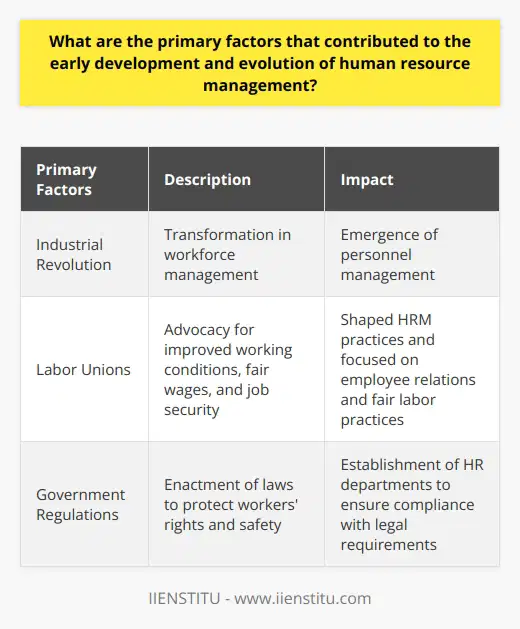
How has the role of human resource management changed and adapted throughout history to address varying societal and organizational needs?
The Evolution of HRM
The role of human resource management (HRM) has undergone significant transformations throughout history to cope with evolving societal and organizational demands. Early HR practices can be traced back to ancient civilizations, such as China, Greece, and Egypt, where attention was mainly focused on overseeing workforce duties, recruiting soldiers, and maintaining a productive labor force.
Shift to Industrial Revolution
The Industrial Revolution created a substantial shift in HR's role, with the emergence of mass production and large-scale organizations. Consequently, HRM began focusing on streamlining recruitment processes, providing apt training, and implementing adequate working conditions for laborers.
Emergence of Welfare Officers
The 20th century saw another major change, with the introduction of welfare officers who assisted employees with concerns like health, safety, and well-being. Following World War II, the importance of personnel management grew due to increased labor shortages and unionization, and HRM specialists became responsible for employee selection, development, and evaluation.
Shift Towards Strategic HRM
The late 20th century marked the transition towards strategic HRM, prompted by the changing business environment and increased global competition. HRM began to emphasize developing and retaining human capital, with an increased focus on aligning people management practices to business strategies. The emergence of modern HRM saw a comprehensive focus on maximizing overall organizational effectiveness.
Embracing Diversity and Inclusion
As societal awareness broadened, HRM expanded its role in fostering diversity and inclusion. HR professionals now recognize the value of a diverse workforce and ensure that inclusive practices promote equal opportunity, avoid discrimination, and support cross-cultural competencies.
Impact of Technology
Significant technological advancements have revolutionized HRM, with automation and software systems streamlining traditional HR functions such as recruitment, training, and performance management. Furthermore, the increasing reliance on remote work has necessitated redefining the way HR approaches employee engagement and well-being.
Conclusion
The role of HRM has continuously adapted to address the varying societal and organizational needs throughout history. From its origins in workforce supervision to its immersive role in strategy, technology, and diversity today, contemporary HRM is a critical function in the ever-evolving business landscape.
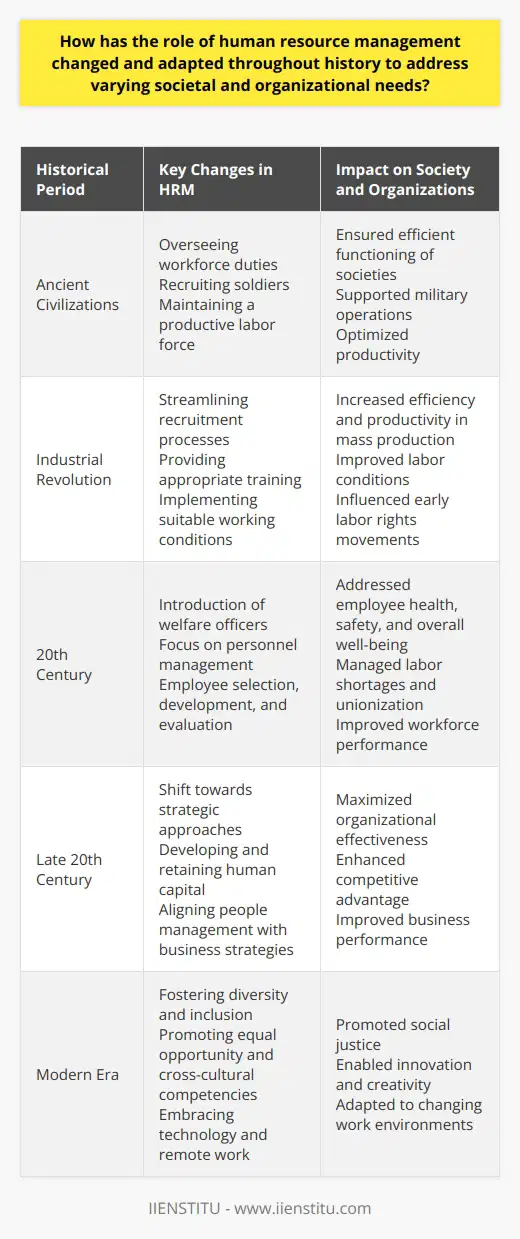
What significant historical events or trends have significantly influenced the way human resource management has evolved into its current form?
Impact of Industrial Revolution
One of the most significant historical events that influenced human resource management (HRM) is the Industrial Revolution. It occurred during the late 18th and early 19th centuries, leading to the rise of factories, mass production, and urbanization. The growing demand for labor in manufacturing industries necessitated the development of HRM practices such as recruitment and training to ensure a steady and skilled workforce.
Evolution of Employment Laws
Another factor that significantly impacts HRM is the enactment of employment laws. Some of these laws came into existence from the late 19th to the mid-20th century, addressing essential employment rights and workplace conditions. Acts like the Fair Labor Standards Act (1938) and the Civil Rights Act (1964) in the United States set crucial milestones for HRM in handling employee protections and discrimination-free workplaces.
Globalization and Technology Advancements
Globalization and technology advancements have dramatically influenced HRM practices in recent decades. The rapid expansion of organizations across national borders has led to the need for culturally diverse and globally competent employees. As a result, HRM practices have evolved to focus on global talent management, cultural intelligence, and effective communication.
At the same time, technology advancements have revolutionized HRM practices, from using computers for data management to the current adoption of artificial intelligence and machine learning. These tools streamline HRM processes like recruitment, onboarding, performance management, and employee benefits administration, ultimately affecting the role of HR professionals.
Shift to Strategic Human Resource Management
A significant trend in HRM has been the shift from traditional administrative tasks to strategic human resource management (SHRM). In the late 20th and early 21st centuries, organizations began to recognize the importance of aligning HRM with their overall business strategies. In SHRM, HR professionals focus on long-term planning to develop and retain an effective workforce, thereby enhancing organizational performance.
Conclusion
In conclusion, the evolution of human resource management into its current form has been significantly influenced by various historical events and trends. Key factors include the Industrial Revolution, employment laws, globalization, technology advancements, and the shift to strategic human resource management. These events have informed how HRM practices are developed and implemented, ultimately shaping the role of HR professionals in contemporary organizations.
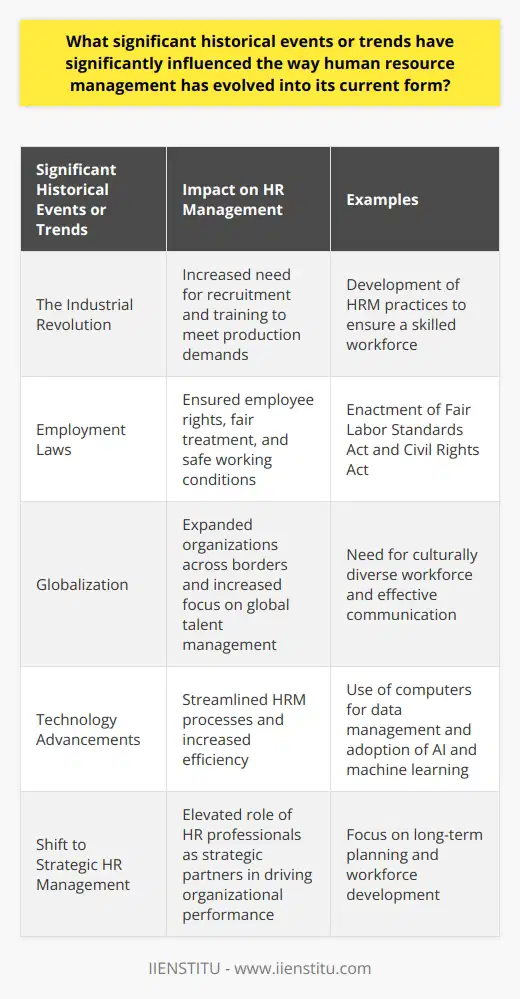
What started the evolution of the human resource function?
Origins of Human Resource Function
The evolution of the human resource function can be traced back to the early developments in industrialization and labor movements. Specifically, the advent of factory systems in the late 18th and early 19th centuries led to a major shift in the organization of labor and the management of employee relations (Martinez-Lucio & MacKenzie, 2012). At that time, the primary concern of employers was to maximize productivity and maintain control over the workforce.
Influence of Scientific Management
One of the earliest drivers of the human resource function was the emergence of scientific management in the 20th century, a concept developed by Frederick Winslow Taylor (Kressler, 2003). Taylor's principles of scientific management sought to establish standardized processes and efficiency in the workplace. This involved breaking down tasks into smaller units, defining clear job roles and responsibilities, and adopting a systematic approach to employee training and development.
Rising Labor Movements
The rise of labor movements and trade unions also contributed to the development of the human resource function, as it became increasingly important for businesses to manage the demands of employees relating to wages, working conditions, and other benefits (Legge, 2005). Employers began to acknowledge the need for organized personnel management, which led to the establishment of dedicated departments and roles responsible for dealing with labor-related issues.
Role of Government Regulations
Moreover, as governments increasingly recognized the need to protect the welfare of employees, labor laws and regulations began to be implemented, which further prompted the development of the human resource function (Farnham, 2015). Employers were required to comply with legal mandates pertaining to minimum wages, working hours, employee safety, and other pertinent labor standards. Consequently, the scope of human resource management expanded beyond simply addressing employee grievances and productivity, to ensuring compliance with regulatory requirements.
Shift Towards Strategic Human Resource Management
With the growing recognition of the importance of human capital in fostering organizational success, the human resource function has gradually evolved into a strategic function that aligns employee skills and competencies with organizational goals (Boxall & Purcell, 2011). As a result, contemporary human resource management involves a wide range of activities, including talent acquisition, employee engagement, performance management, and succession planning, aimed at enhancing overall organizational effectiveness.
In conclusion, the evolution of the human resource function can be attributed to a confluence of various factors, including the rise of industrialization, the advent of scientific management, escalating labor movements, and the proliferation of government regulations. Throughout its progression, the human resource function has adapted to address the evolving demands of organizations and employees, eventually emerging as a critical strategic component in driving organizational performance.

What are the three stages of evolution of human resource management?
Stages of Human Resource Management Evolution
Understanding the development of human resource management is essential to grasp how modern organizations manage their workforce. The three stages of human resource management evolution are the administrative, behavioral, and strategic stages.
Administrative Stage
The administrative stage commenced in the early 1900s when organizations primarily focused on hiring, payroll, and personnel record-keeping. The foremost objective of human resource management at this time was to maximize employee efficiency and reduce the high turnover rates prevalent during the industrial revolution. Human resource professionals were predominantly involved in setting standard wages, hiring and firing decisions, and maintaining necessary documentation.
Behavioral Stage
The behavioral stage emerged in the 1950s and 1960s, primarily due to the rise of labor unions and an increased focus on employee engagement. In this stage, human resource management shifted its emphasis from the purely administrative tasks towards improving employee motivation, satisfaction, and performance. Organizations began to adopt team-building exercises, training programs, and performance appraisals to comprehend and address employee needs more effectively. This stage recognized the significance of the human aspect in workforce management, and leaders acknowledged that employee well-being correlated with organizational success.
Strategic Stage
The strategic stage, which began in the 1980s and continues to evolve, emphasizes aligning human resources with the organization's overall goals and visions. In this stage, human resource management is viewed as a strategic partner to the organization, essential for achieving competitive advantage. This level of involvement necessitates human resource professionals to participate in strategic planning processes, voice their perspectives in core business decisions, and maintain a comprehensive understanding of the organization's industry and market conditions. The strategic stage emphasizes recruiting top talent, fostering leadership, developing the workforce's skills, and promoting a strong organizational culture.
In conclusion, human resource management has evolved significantly over the last century, beginning with the administrative stage and followed by the behavioral and strategic stages. Each stage has brought new perspectives to workforce management, contributing to today's complex and dynamic understanding of human resource management. The constant evolution ensures that organizations continue to adapt their workforce strategies to stay competitive in an ever-changing business environment.

What is the evaluation of human resource management?
Defining Human Resource Management Evaluation
Human resource management (HRM) evaluation is the systematic process of collecting and analyzing data to measure the effectiveness of HRM policies and practices. Through this evaluation, organizations can identify areas for improvement and allocate resources for appropriate HR interventions.
Assessing HR Systems and Policies
HRM evaluation begins with examining an organization's HR systems and policies. This includes assessing recruitment and selection procedures, training and development programs, performance management systems, and compensation structures. By analyzing these aspects, organizations can determine if they align with their overall objectives and support the business strategy.
Measuring HR Outcomes
To effectively measure HR outcomes, organizations often use key performance indicators (KPIs) that reveal the success or failure of specific processes or interventions. Examples of KPIs include employee turnover rates, the number of open job positions, employee satisfaction scores, and the average time to hire. These metrics help organizations gauge the effectiveness of their HRM strategies in attracting, developing, and retaining employees.
Evaluating Employee Performance
A critical aspect of HRM evaluation is assessing employee performance. Organizations must establish clear performance expectations for employees, and managers should discuss them regularly with their subordinates. Performance appraisals can provide valuable information on individual employees' strengths and weaknesses, allowing organizations to make evidence-based decisions regarding promotions, compensation, and professional development.
Benchmarking and Comparison
Another dimension of HRM evaluation is benchmarking, which allows organizations to compare their HR practices and outcomes against industry standards or other successful companies. This process can reveal areas where the organization lags behind its peers and identify best practices for adopting or adapting. Benchmarking provides actionable insights that can enhance the effectiveness of an organization's HRM policies and create a more competitive workforce.
Continuous Improvement and Development
Overall, the evaluation of HRM is an essential aspect of an organization's ongoing success. By continually monitoring and analyzing HR policies, practices, and outcomes, organizations can identify areas for improvement and implement targeted interventions. The findings from HRM evaluations assist organizations in meeting their strategic objectives, improving employee satisfaction and engagement, and fostering sustainable growth.

What are the 5 stages of evolution of HRM?
Stages of HRM Evolution
Administrative Phase
The first stage of human resource management (HRM) evolution is the administrative phase. During this period, HRM primarily focused on personnel administration, record-keeping, and day-to-day management of employee-related activities. The main objective was to ensure adherence to laws and regulations, creating a formal structure to manage employees effectively.
Industrial Relations and Welfare
The second stage of HRM evolution, known as the industrial relations and welfare phase, emerged during the early 20th century as industrialization expanded rapidly. HRM began to take on a more critical role in organizations, dealing with issues such as labor unions, workplace safety, and employee welfare. This period saw the development of labor laws and regulations, which became essential components of effective HRM practices.
Scientification and Human Relations Era
During the scientification and human relations era, the third stage of HRM evolution, organizations started to adopt scientific management principles. This period, spanning the mid to late 20th century, marked a significant shift in HRM approaches, prioritizing the human aspects of organizations. Factors such as motivation, productivity, employee satisfaction, and organizational culture became central to HRM, leading to the development of various psychological and sociological theories.
Strategic Integration Phase
As the focus on human relations grew, the fourth stage of HRM evolution, the strategic integration phase, emerged. In this stage, HRM began to align its functions and practices with organizational goals and strategies. HR professionals started playing a more significant role in shaping organizational structures, contributing to overall business success. This period marked the transformation of HRM from a support function to a strategic business partner.
Global Era and Technological Advancements
The fifth and current stage of HRM evolution is the global era, characterized by rapid technological advancements and increasing diversity in the workforce. In this stage, HRM functions have transcended geographical boundaries, requiring organizations to manage global teams effectively. HRM professionals now need to develop and implement policies and practices that cater to a diverse and global workforce, focusing on talent management, employee engagement, and inclusivity.
In conclusion, the evolution of HRM has passed through five distinct stages, starting from basic administration and culminating in the current era of global management and technological advancements. The growing importance and impact of HRM on organizations and employees require continuous adaptation and innovation to ensure effective management of human resources in today's complex and challenging business environment.
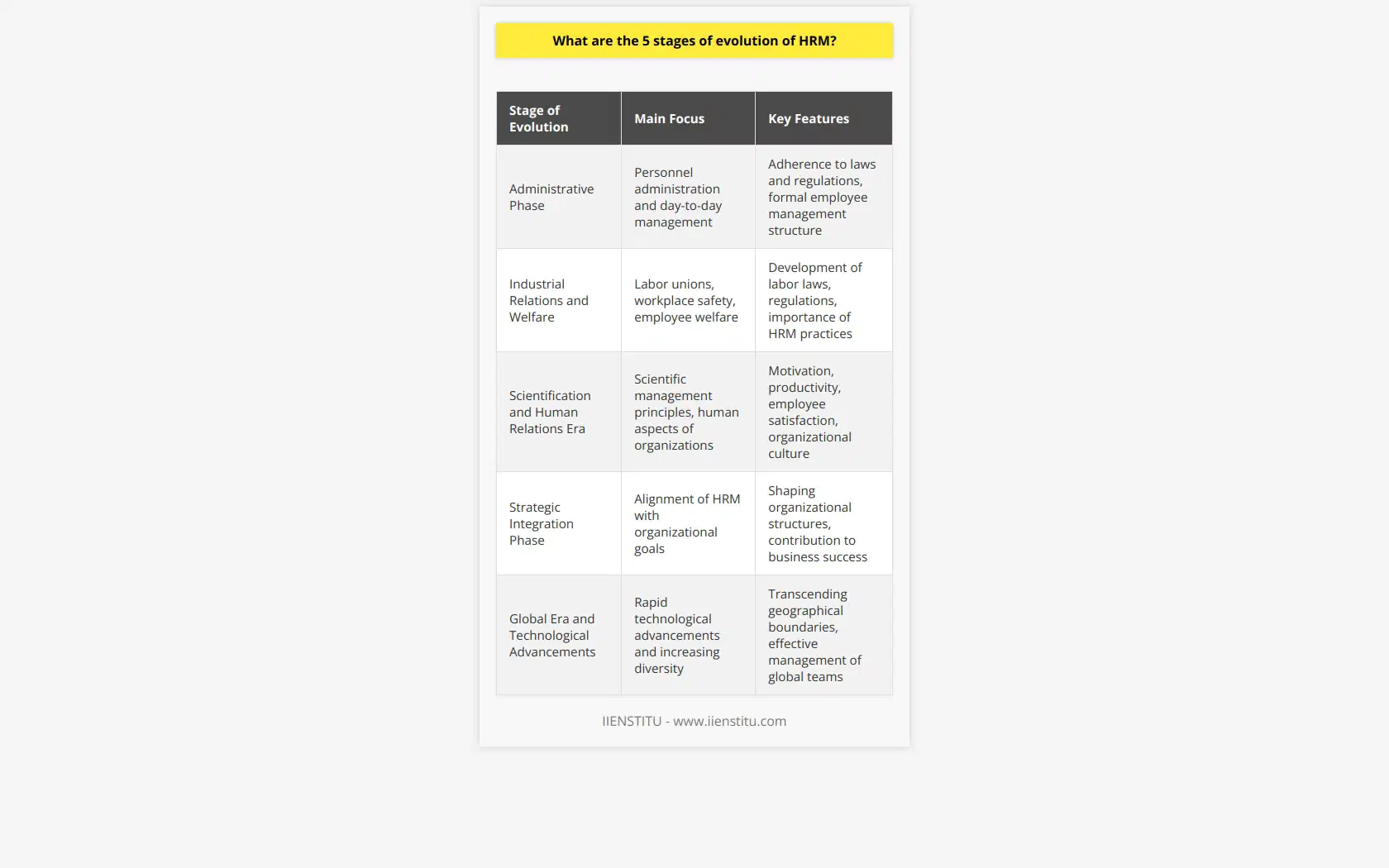
What started the evolution of the human resource function?
Origins of the HR Function
The inception of the human resource function can be traced back to the late 19th and early 20th centuries, during the industrial revolution. Several factors contributed to the gradual emergence of this essential business function, such as scientific management, labor unions, and governmental regulations.
Scientific Management
First, the principles of scientific management, proposed by Frederick Taylor in his 1911 book, 'The Principles of Scientific Management,' emphasized the need for an organized approach to managing the workforce. Taylor's ideas led to the creation of personnel departments and the establishment of dedicated staff to manage employees. The primary goals of these departments were to improve employee productivity, develop systematic hiring processes, and foster effective communication.
Labor Unions
Another factor that contributed to the evolution of human resources was the rise of labor unions. As working conditions in factories during the industrial revolution were often substandard and exploitive, the formation of labor unions emerged as an essential development for the protection and advocacy of workers' rights. The presence of labor unions necessitated employers to engage in organized discussions and negotiations regarding workers' salaries, working conditions, and benefits. Consequently, companies established human resource functions to address these demands and maintain a healthy relationship with labor unions.
Governmental Regulations
The third factor in the emergence of human resources was the introduction of employment-related legislations by governments. In the early 20th century, several labor protection laws, such as the Fair Labor Standards Act and the National Labor Relations Act, were enacted in response to the mass industrialization and the growing need to protect workers from exploitation. As a result, the human resource function expanded to ensure compliance with these labor regulations and reduce the risk of legal troubles for organizations.
In conclusion, the evolution of the human resource function arose mainly from the principles of scientific management, the impact of labor unions, and the implementation of governmental regulations. Thus, the fundamental objective of human resources emerged as a means to manage a diverse and growing workforce effectively and ethically, fostering better relationships between employers and employees.

What is evaluation of human resource management?
Evaluation Framework
The evaluation of human resource management is a process of systematically measuring and analyzing the effectiveness and efficiency of human resource (HR) policies, practices, and systems within an organization. This involves assessing the contributions of HR functions to the organization's overall performance, as well as determining whether the organization's HR strategies, processes, and programs are aligned with its goals and objectives, and comply with relevant laws and regulations.
Methods and Techniques
Various methods and techniques can be employed to evaluate HR management, including quantitative and qualitative approaches. Quantitative methods involve the collection, analysis, and interpretation of numerical data, while qualitative methods rely on non-numerical data, such as interviews and observations, to gain insights into HR practices and their impact on organizational performance. Commonly used quantitative techniques include key performance indicators (KPIs), benchmarking, and surveys, while qualitative techniques may involve focus groups, case studies, and expert interviews.
Outcome-Based Evaluations
Outcome-based evaluations focus on the measurable outcomes of HR management in relation to the organization's goals and objectives. Such evaluations often involve the identification and assessment of specific HR goals and objectives, followed by the measurement and analysis of key performance indicators (KPIs). For example, an HR department may set a goal to improve employee engagement, and use KPIs, such as employee satisfaction scores, retention rates, and productivity levels, to evaluate its success in achieving this goal.
Process-Based Evaluations
In contrast, process-based evaluations examine the effectiveness and efficiency of HR processes and systems, which are often closely related to HR outcomes. For example, a process-based evaluation may involve examining an organization's recruitment process to ensure it is attracting and selecting the right candidates, or assessing the efficacy of its training and development initiatives in building the skills and competencies required by the workforce. These evaluations may use both quantitative and qualitative data to assess the success of specific HR processes, and identify areas for improvement.
Legal and Ethical Compliance
In addition to assessing HR outcomes and processes, evaluations of human resource management should include considerations of legal and ethical compliance. Organizations must ensure that their HR practices adhere to relevant laws regarding employment, safety, and anti-discrimination, as well as align with ethical standards and expectations. Evaluations in this area may involve conducting internal audits, seeking external legal advice, or engaging in benchmarking activities to compare the organization's HR practices with those of its peers and industry standards.
In conclusion, the evaluation of human resource management involves a systematic and comprehensive examination of an organization's HR policies, practices, and systems, with the aim of determining their effectiveness in achieving organizational goals and objectives, as well as ensuring legal and ethical compliance. To achieve this, a range of quantitative and qualitative methods and techniques can be employed, focusing on outcome-based or process-based evaluations, bolstered by considerations of legal and ethical compliance. Such evaluations contribute to the continuous improvement of HR management, facilitating the development of policies, practices, and systems that enhance the performance and competitiveness of the organization.
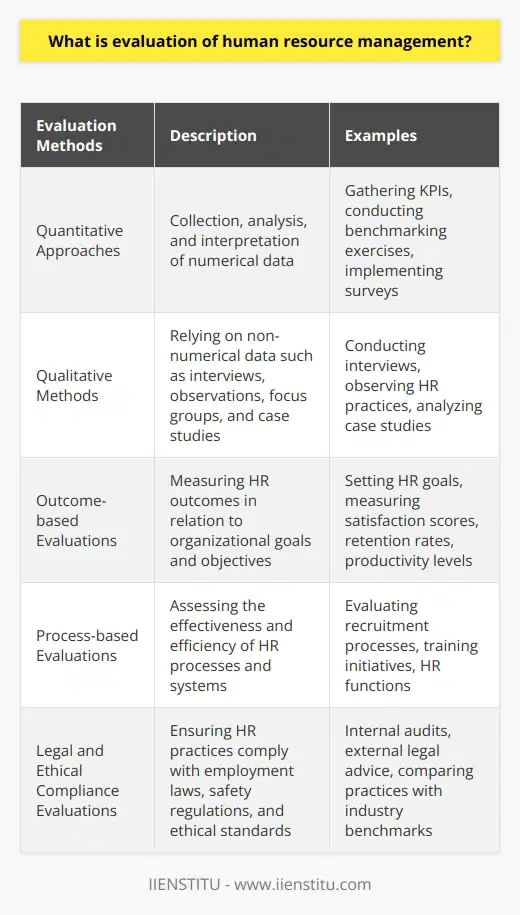
What factors have driven the continuous evolution of human resources management?
Drivers of Human Resources Management Evolution
Organizational Context
Organizational context plays a significant role in the evolution of human resources management (HRM). Companies' growth, global expansion, and changes in organizational structures necessitate different HRM practices.
Technological Advancements
Technology also influences HRM evolution greatly. It reshapes the landscape of HRM practices including recruitment, training, and performance management. Advanced systems and software streamline workflow and automate repetitive tasks, enhancing efficiency.
Workforce Diversity
The diversity and changing nature of the workforce also drive HRM evolution. It necessitates the application of different employee management strategies. Adjustments in HRM practices are required to accommodate different cultures, generations, and working styles prevalent in a diverse workforce.
Changing Environment
The ever-changing environment prompts continuous modifications in HRM. The unpredictability of business, societal norms, and economic environments requires agility from HRM. Adapting to these changes is necessary to stay relevant and competitive.
Employee Expectations
The increased recognition of employee rights and needs have sparked changes in HRM. They now demand a healthy work environment, better work-life balance, and continuous learning opportunities. HRM has to evolve to meet these expectations.
Legal Compliance
Strict legal requirements and increased regulatory scrutiny are also significant drivers. New laws necessitate compliance, requiring HRM to adapt. Non-compliance can cause hefty penalties and negative publicity.
In sum, HRM must keep evolving in response to changing organizational needs, technological advancements, workforce diversity, a shifting environment, and evolving employee expectations, while adhering to regulatory compliance.
Conclusion
The continuous evolution of HRM is a step towards building more resilient and competitive organizations. Various external and internal factors force this change. Understanding these drivers is essential to steer HRM in the right direction.

How have technological advancements impacted the development and transformation of HRM practices?
Technological Influence on HRM Development
Technological advancements hold a significant impact on human resource management (HRM) practices. They transform traditional methods, making HRM operations more efficient.
Recruitment Process Upgrade
One clear demonstration of this transformation is within the recruitment process. Online platforms now simplify job advertising and applicant sorting.
Convenient Training and Development Programs
Moreover, technology paves the way for convenient online training and development programs. These technological tools enable professionals to attain valuable skills at their convenience.
Employee Performance Management
Progress in technology also changes how HR manages employee performance. Various assessment tools now deliver precise, real-time performance data, enabling effective management decisions.
Paperless HR Operations
Technology also enables a shift towards paperless HR operations. Digital storage and data management systems eliminate the necessity for physical files, reducing cost and improving efficiency.
Improved Employee Communication
Lastly, advancements in communication technology foster workplace collaboration and employee engagement. This digital transformation ensures seamless information flow across different organizational levels.
The Shift to Remote Work
The advent of cloud computing facilitates remote work, allowing HRM to adapt to this new employment model. HR tools have been designed to track and monitor remote employees' performance, tasks and hours worked efficiently.
Concluding Thoughts
In conclusion, technology transforms HRM practices, making them more efficient, time-saving, and cost-effective. Nonetheless, HR professionals must stay updated with these advancements to maximize their benefits.
Ultimately, understanding the powerful role of technology in HRM is indispensable for today's organizations. As the digital age continues to evolve, this role will only become more significant.

In what ways has the increasing emphasis on employee well-being and work-life balance influenced the evolution of human resources management?
Emphasizing Employee Well-being
The trend of prioritizing employee well-being has significantly influenced the evolution of human resource management. It lays a strong emphasis on employees' mental, physical, and emotional wellness. It has ushered in new policies and practices aimed at promoting healthier work environments.
Work-life Balance Importance
Another crucially influential factor is the growing importance of work-life balance. Companies realize that overworked employees can lead to burnout and decreased productivity. In response, human resource management strategies now prioritize flexible work schedules and remote work opportunities.
Role of Human Resources
Human Resource Management (HRM) has consequently evolved from a primarily administrative function to a more strategic role. HRM now includes aspects such as employee engagement, satisfaction, personal development, and well-being. These facets align the organization's strategies with their employees' welfare.
Policy Implementation
Increased emphasis on employee well-being and work-life balance has influenced HRM in the formulation and implementation of policies. Policies such as wellness programs, mental health support, adequate leave programs, training, and skill development initiatives have become common. These measures ensure employee satisfaction and longevity within organizations.
Technological Integration
The notion of worker well-being has also hastened the integration of technology in HRM. The use of contemporary HR technology has made it easier to manage flexible schedules, time-off requests, performance evaluations, etc.
Impact on Recruitment
The increased focus on employee well-being influences organizations' recruitment approaches. Businesses are now keen to project an image of a humane workplace that values employee well-being.
In conclusion, the increased emphasis on employee well-being and work-life balance has profoundly shaped HRM. Policies favoring these aspects have become a norm, leading to significant changes in HR practices. These changes aim to create a healthy work environment, anchoring worker welfare as a pivotal organizational goal.



